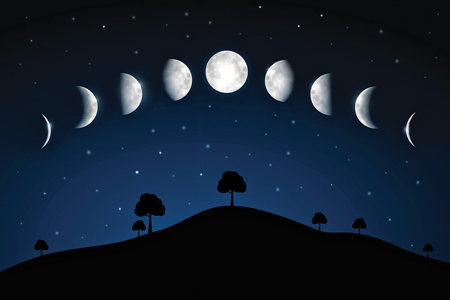New Year, New Moon

By Margo Graf
“The glory of gardening: hands in the dirt, head in the sun, heart with nature. To nurture a garden is to feed not just the body, but the soul.”– Alfred Austin
With the influx of new Sci-Fi movies and shows, we have seen a lot of the fantastic marvels of the universe. “The Expanse,” “The Guardians of the Galaxy,” “Stranger Things,” “The Martian,” have all brought distant galaxies into our living rooms with incredible screenplay. As impressive as these movies are, we often overlook an important rock much closer to home.
People forget the moon also sets in the west. If you really think about the moon and what it means to earth, you might appreciate it more–even when it is not fully demanding our attention.
Our past runs deep with reliance on the moon. From the beginning of time, people have used the moon to grow food (aka survive). Vastly different cultures from around the world followed the exact same planting traditions in accordance to the moon cycle. Ancient Chinese, Cherokees, Mayans, Hawaiians, Scottish Highlanders and so on, all had the same tradition without knowing of the others’ existence. The moon, it turns out, is quite dependable.
Since spring will be here in a few months, it is time to start thinking about your garden plans. It just so happens; vegetables and flowers are greatly influenced by the moon cycle.
Before we get into the specifics, it is best to understand Moon Basics 101. First, the moon’s orbit lasts for 29 and a half days and is divided into quarters. The cycle starts and finishes with a new moon. The new moon gets drowned out by the sun’s glare and is invisible to us–worry naught it is there. This cycle happens because the sun and moon do not revolve at the same speed. The moon is in fact 12 degrees slower than the sun.
The 1st quarter is the beginning of the dark moon. The moon pulls the water table up towards the surface which moisturizes the soil. Plant lettuce, cabbage, spinach, broccoli, cauliflower, celery and other leafy, above-ground vegetables during this quarter.
The 2nd quarter has less pull on the water table, but there is more moonlight. This enhances leaf development and is the best to harvest fruit, as they will have more moisture. Plant tomatoes, peas, beans, melons, cucumbers, and squash during this quarter.
The 3rd quarter the moon is waning. There is less pull on the earth and less moisture. The plants have slowed their growth and are ready for planting or pruning. Harvest sweet potatoes, carrots, beets, and other root crops during this quarter.
The 4th quarter is for cleaning and preparing. It is believed that the lack of moonlight helps to keep grass and weeds from returning quickly since their seeds do not germinate. Clear ground, cut back grasses, and weed the soil during this quarter.
During waning or waxing periods, the sun’s light casts shadows over the moon’s Riphaeus Mountains and craters. Look closely during a quarter phase and you will see small shadows across the face. When the moon is full, the entire surface is reflected back to us. You can tell that it is a full moon by the brightness. The moon does an interesting trick called the “opposition effect.” Instead of giving off twice the amount of light during a full moon compared to a half or crescent moon… it gives off ten times the amount of light! The day before and the day after a full moon will not have the same intense glow.
As you slowly start thinking about what harvest you would like for 2018, it is a good idea to plan your movements with the moon cycle. There are forums online that will also guide you with how and when to take action. It is quite a cool notion that what happens light-years away actually has an affect on our Carolina clay. There is some truth within the science fiction we see on the big screen. May the moonlight be with you.

